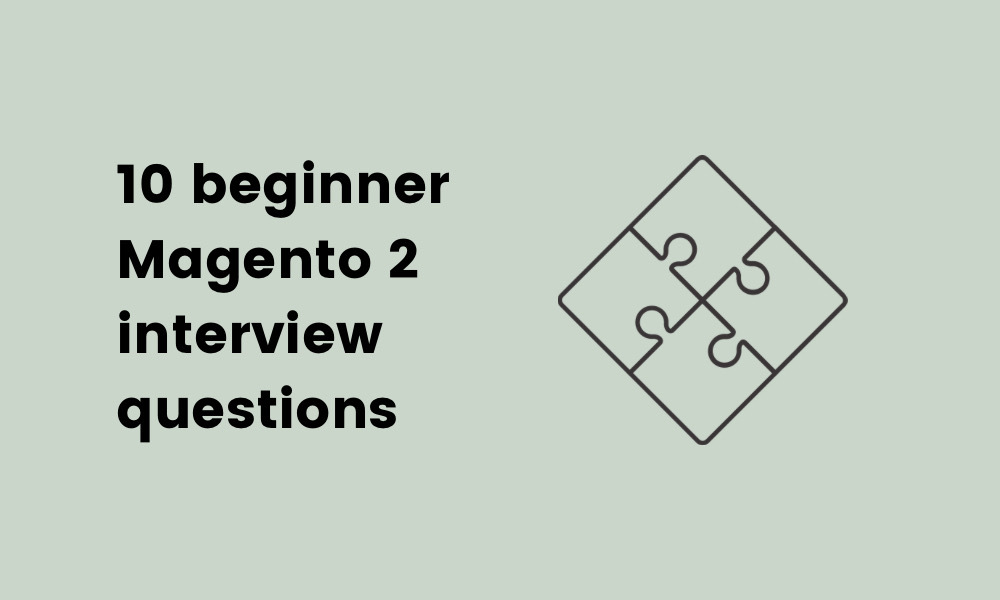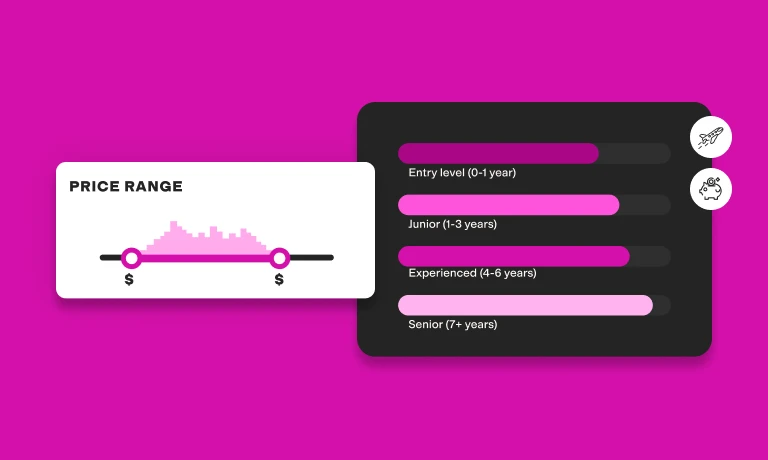25 Magento 2 interview questions to hire top developers
If your organization is about to start building an e-commerce store, you’ll likely need the help of an expert who has top front-end skills, and who is proficient in Magento 2.
One of the best ways to ensure that you hire a candidate who has the right level of expertise is to administer a Magento 2 test to shortlist your best candidates, and then to invite them to an interview.
The interview is a critical component of the hiring process, but to make the best of it, you need to ask your candidates the right Magento 2 questions, adapted to the seniority level of the role.
Hiring a good Magento developer is essential for the success of your business. Since knowing which questions to ask can be challenging, we’ve created this article to help you come up with the right ideas and accurately assess your applicants’ skills.
Below, you’ll find the top 25 Magento 2 interview questions to ask your candidates, divided into categories based on their experience level.
10 beginner Magento 2 interview questions
The questions listed in the first section are suitable for junior front-end developers who have limited experience with Magento 2.
1. What is Magento 2 and what is it used for?
Sample answer:
Magento 2 is an open-source programming platform that was created specifically to help developers build and develop e-commerce platforms or stores. Its main programming (or backbone) language is PHP. Essentially, Magento 2 is a content management system that has scalable architecture.
2. When scripting in Magento 2, which language and framework should be used?
Sample answer:
The programming language that should be used for scripting in Magento 2 is PHP. It also uses frameworks for PHP, including the Symfony and Zend Frameworks.
3. What does compilation mean in Magento 2?
Sample answer:
Compilation is a feature that facilitates the process of compiling files to enhance code performance. One of the advantages of compilation is that the load speed of the page can increase by up to 50%.
4. What are the key advantages of using Magento 2?
Sample answer:
There are several critical advantages of using Magento 2, as it:
Has a number of features that enhance SEO
Features security tools that are customizable
Helps build mobile-friendly online stores
Permits easy integration with leading marketplaces to produce omnichannel experiences
Provides an enhanced user experience with a wide range of search features
5. What is meant by EAV? Can you explain what it means?
Sample answer:
EAV is an acronym that refers to entities, attributes, and values, which are components of the Magento module architecture:
Entities refer to items of data such as the products or customers of the e-Commerce store
Attributes refer to the many potential attributes that all data elements can be assigned, for example a product name
Values refer to the elements of data that characterize the attributes; for instance, a product could have the value of “large” or “small”
6. Can you name the key products that Magento 2 supports?
Sample answer:
There are several main types of product that Magento 2 supports, including but not limited to:
Virtual
Simple
Grouped
Downloadable
Configurable
7. Which deploy modes can be used in Magento 2 and what are their main differences?
Sample answer:
Some of the main deployment modes of Magento 2 are production, developer, and default:
Production mode is used for application production and since the pub/static directory populates static view files, the performance is enhanced.
In developer mode, debugging is usually carried out to enhance the compilation efficiency
Default mode is the default Magento 2 mode that doesn’t have additional features or custom settings
8. What is a Magento dependency injection?
Sample answer:
If a developer wants to replace certain Magento class features, they can do that with Magento 2’s dependency injections, which are design patterns.
Dependency injections permit objects to show their dependencies. For example, an object can “receive” dependencies, which are other objects required by them. Developers can use ObjectManager to produce objects that have a certain class.
9. Why do developers need to use the factory class in Magento? What are the benefits of factory classes?
Sample answer:
If a developer needs to produce code from square one, they can use a factory class. Factory classes are handy features that let developers make changes to an entity record and avoid disrupting any dependency injections in the process.
10. Describe what the Magento API is and how it’s used.
Sample answer:
As a framework used in Magento, the API permits you to send and receive requests and responses from core code to external systems and vice-versa.
There are a few key features that make the Magento API particularly useful. Not only does it support SOAP (simple object access protocol) principles, it also supports REST (representational state transfer) principles.
7 Intermediate Magento 2 interview questions
Use the intermediate Magento 2 interview questions listed below to find out if your candidates have the right skills for a mid-level front-end developer role.
1. Can you name two methods used in Magento 2 to count products?
Sample answer:
Counting products can be done in two ways in Magento 2:
getSize()
count()
Most developers consider that getSize() is efficient and doesn’t accumulate any repeated collection load time. Using the count() approach will cause the application’s performance to slow due to the repeated collection reload.
2. Which design patterns are you aware of in Magento 2?
Sample answer:
There are 12 different design patterns that Magento 2 supports. If I remember correctly, the 12 design patterns include:
Prototype pattern
Module pattern
Object pool
Front-controller
Registry pattern
Model-view-controller pattern
Factory pattern
Singleton pattern
Service locator
Lazy loading pattern
Iterator pattern
3. What makes Magento 2 better than Magento?
Sample answer:
For me, Magento 2 is better than Magento since developers can manage the architecture easily, which wasn’t the case for Magento.
It’s also more efficient due to its load speed—pages load faster and perform much better compared to Magento 1. Its mobile-friendly panel and backend user interface also makes it easier to use.
4. How would you describe what static blocks are in Magento 2?
Sample answer:
If a store page has information that is unchangeable, developers use static blocks to host them. Static blocks are commonly used to add a banner or advertisement to an e-Commerce store page. They are also referred to as content blocks or content management system blocks.
5. How would you produce a custom module using Magento 2?
Sample answer:
There are a few steps that I would use to produce a custom module using Magento 2.
I would start by making a module folder and create an etc/module.xml file. Next, I would make a registration.php file and install the module by running the bin/magento setup:upgrade script. Once done, I would check whether the module works and is active.
6. Which file structures are used by Magento 2?
Sample answer:
The file structure that Magento 2 can contain includes blocks, models and controllers. Each of these correspond to specific features, which might include a user login, for example. Structures can be customized.
7. What is the advantage of EAV in Magento 2?
Sample answer:
The main advantage of EAV (Entity-Attribute-Value) in Magento 2 is that it helps to maintain order in the store architecture. There are also benefits for the back-end, as EAV helps optimize the architecture. With the EAV model, developers can flexibly store and gain access to data, and if they need to add any attributes, there would be no need to adjust the database structure.
The best insights on HR and recruitment, delivered to your inbox.
Biweekly updates. No spam. Unsubscribe any time.
8 advanced Magento 2 interview questions
Choose from the advanced Magento 2 interview questions below to learn whether your senior-level front-end developers can use Magento 2 effortlessly.
1. Which approach would you use in Magento 2 to set up an e-commerce store that sells products in different countries?
Sample answer:
I think the most efficient way to establish an e-commerce store like this would be to produce two separate payment scopes. This is because if each geographical location has a unique payment method, two payment scopes are needed.
However, I would stick to one website. Since one store view would fail to manage the payment and two websites would have two different URLs, two payment scopes on one website seem to be the best option.
2. Can you name two web servers that are needed for Magento 2?
Sample answer:
Since Magento 2 can support Nginx and Apache, two main web servers that are needed for Magento 2 include Nginx1 (and Nginx web servers above this version), and Apache 2.4.
3. How is cache:clean different from cache:flush?
Sample answer:
These two are similar commands, but carry out very different functions. Whereas a cache:clean option will remove the items only in enabled types of cache in Magento, cache:flush can remove all stored items, which also includes those of the third party.
4. What is your approach to deploying Magento in the cloud?
Sample answer:
I would first use Adobe Commerce, which provides a hosting infrastructure and system code that is ready-to-use. Then, I would draw upon my knowledge of CLI tools and examine logs to try and resolve any issues in deployment.
Since the Git branch doesn’t get activated until a developer actually accesses GitHub, I would use a Magento cloud command to activate it.
5. Do you know any cache systems? What do they help you achieve?
Sample answer:
I have experience with Varnish and have configured and used it extensively. The Varnish cache system helps you reduce the response time of the site in addition to the consumption of bandwidth when customized and configured correctly. It’s a good option for optimizing a project or e-Commerce store in Magento.
6. What are the best practices for programming in Magento 2?
Sample answer:
Some programming best practices for Magento 2 that I try to follow include:
Testing all code prior to releases
Writing replaceable code to facilitate enhancements or upgrades
Using consistent case conventions
Using SOLID concepts and principles when coding
Implementing the Magento Coding Standard when creating extensions or customizations
7. Which approaches could you use to adjust the behavior of Magento 2?
Sample answer:
I am aware of three key approaches to adjust the behavior of Magento 2:
Rewriting functions: If you want to change a single function you can rewrite it. To do that, you would need to specify a particular class that the file contains, and it’s possible to extend the parent class using this approach.
Observer: It’s possible to intercept and alter an event by using observers. They help you run code that corresponds to certain events (which may be custom ones).
Monkey Patches: I wouldn’t recommend this approach, but it is used to modify and overrule modules even though they are loaded in a certain order in Magento. This process means that the whole class is rewritten.
8. If you wanted to add new themes, how would you do this in Magento 2? Which steps would you take?
Sample answer:
There are a few steps involved in adding new themes in Magento 2. I would first make a directory and then declare the theme. Next, I would distribute the theme by adding composer.json file to the directory of the theme. I would register this package on a server, then configure the images.
Since the theme would have many static files, knowing and understanding file structures and how they are stored is important for creating new themes. Once I had created a directory for the static files, I would then work on the theme logo.
5 recommendations for using Magento 2 interview questions
When you use these Magento 2 interview questions, keep the following five recommendations in mind during the interview process:
Before you begin conducting interviews, evaluate candidates with a skills assessment to better understand how knowledgeable they are, and to identify the best candidates to invite to an interview. With TestGorilla, you can use up to five skills tests in an assessment, which means you can tailor the process to the needs of the role and to get a clear overview of the skills of all applicants. For example, you can use programming skills tests, role-specific tests, cognitive ability assessments and also include personality and culture tests.
Define the level of expertise and knowledge the role demands and match the interview questions’ difficulty level to this. Remember, if you’re hiring for a Magento 2 intern to help with your project, there’s no point in asking them advanced-level Magento 2 interview questions. Select the right questions for the role you’re recruiting for.
If you’re taking notes during the interview, let your candidates know why. Notes can help you better compare candidates after the interview phase, and avoid recency bias, which is one of the common types of interview bias. When taking notes, keep them short and concise.
For senior roles**,** look for candidates who have an in-depth knowledge of user interface (UI) and user experience (UX). Candidates should also be familiar with APIs and their functions during the role.
Avoid hiring based on the needs of a specific project and instead consider how your candidate will fit into your team and grow within your company.
Use Magento 2 interview questions and skills tests to hire the best talent
The right interview questions are important when hiring a Magento 2 developer, but so is the candidate experience. For this reason, try to offer feedback on your candidates’ applications even if they are unsuitable for the position.
Remember that skills testing makes offering feedback easier and will help you reduce unconscious bias during the interview stage. With it, you can easily evaluate your candidates’ Magento 2 skills and hire the best developers for your team. Get started for free today and start making better hiring decisions, faster and bias-free.
You've scrolled this far
Why not try TestGorilla for free, and see what happens when you put skills first.





















